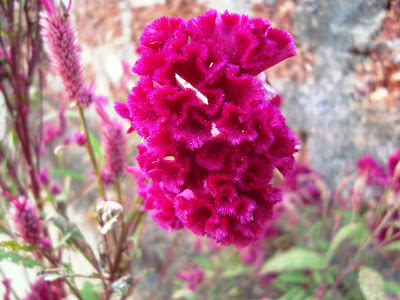 |
| Morpankh or Mayursikha |
Morpankh
or Mayursikha is also called Indivara, Survali, Safedmurga, Kokan, Sarvari,
Sarvali, Surali, Silyari in Hindi, Swet murga, Chorknat, Lenga shak in Bengali,
Kurdu in Marathi, Gurugu aku in Telugu, Makilikkeerai, Pannaikeerai, Pannaipoo
in Tamil, Honnikuk, Anni or Anne Soppu in Kannada, Kozhipoovu, Cheruchira,
Balungayam in Malayalam, Mayura sikha , Jataadhaari in Sanskrit. In India in
different regions it is called in different names locally. In Haryana it is
called Siriyai, Labaru or Lobdi in Gujrat, Chilmili in UttarPradesh, Dalphula,
Garkha, Dondi, Latoor and Lamadi in MadhyaPradesh, Kukdi, Sunedi and Suli in Rajasthan,
Silyari, Singoti and Memri in Chhatishgarh, Salara in Punjabi. In my state Odisha
we call it Sirel or Sirali and Lobanga or Lahanga.
It is known as Cockscomb or Silver cock’s comb, Wild Cock’s Comb , Quail grass and Wool flower in English.
The botanical name is Celosia (popular varieties are Celosia argentea L. Celosia cristata Linn, Celosia Isertii); It belongs to Amaranthaceae family.
Celosia
or Common cockscomb is an erect, annual plant growing 40 to 200 cm tall. The
leaves are ovate to ovate-lanceolate. The flowers look like a cock’s comb. They
are found in a colour range of whitish Pink, red, yellow or orange. The
flowering time is around August -September and occur 6 - 7 weeks after sowing
the seeds if cultivated. The fruiting season is October- December. It is both
cultivated and self-sown through Pollinators, wind, Insects etc.
Its
original Habitat is tropical Africa, and because of tropical origin, it grows
best in good sunlight and warm temperate zones. It is a common weed found
throughout India, in fields, road side, hills and arable lands, wastelands and
almost everywhere. It is sometimes cultivated in African Sub-Continent, for its
edible leaves. The plant is an annual having high seed production rate.
The
plant has great medicinal properties. It is antibacterial, anti-inflammatory, antidiarrheal,
anticancer, antidiabetic, antiscorbutic, antidiabetic, antioxidant, hepatoprotective and antiparasitic also. It is
also an immune-booster, wound healer. The leaves are potassium rich. The
flowers and seed are astringent, ophthalmic, haemostatic. The Seeds are demulcent,
hypotensive, antibacterial.
Celosia species has been widely used in traditional medicine to cure several physical disorders such as jaundice, fever, gonorrhoea, diarrhoea, inflammation, mouth sores and skin-itching, wounds. Extract of its stems and leaves is used to treat skin eruptions, infected sores. The leaves are also used to treat blurring of vision, cataracts (Not Glaucoma), bloodshot eyes. The juice of leaves and flowers is used as a medicinal body wash for convalescents. The leaves also are used to treat arthritis and rheumatism. The flowers are used in treatment of menorrhagia, diarrhoea and blood-dysentery. The seeds have anti-diarrhoeal properties and used in treatment of stomatitis, bloody stool, haemorrhoid bleeding, dysentery and diarrhoea and also in uterine bleeding, leucorrhoea. The whole plant is a good antidote for snakebites. The roots are used in the treatment of eczema, colic, and gonorrhoea. It is used for treatment of physical debility, sugar control in body, muscular pain, urinary troubles. People often collect the seed s make a powder of it and mixing it with warm water gargle regularly to cure bad breath, mouth ulcers, tooth ache etc. 10-12 mg. seed powder is taken and put to 1 glass of water and boiled down to 1 cup; this decoction is taken to treat urinary problems like frequent urination, painful urination, dysuria etc. Half tbsp. seed powder taken with warm milk during night can cure physical debility in few months and taken in morning in empty stomach it also controls sugar. The paste of this seed smeared as a poultice on the aching muscles after long exertion yields very good results.If anyone’s urine is blocked then the seed powder is taken to release the blockage. The seed powder is also used to treat uterus prolapse in animals while giving birth. The leaves cooked as vegetable is a good bowel cleanser.
 |
| Celosia |
The Celosia flower is beautiful and the plant is cultivated chiefly for ornamental purpose. The Seeds can render an edible oil. The tender leaves and young shoots are cooked as a leafy vegetable, as soups and stews. It tastes like spinach. That is why it is grown so much in Tropical Africa, South America and in many countries of Southeast Asia. In India the leaves are often used as leafy veg or popularly known as saag.